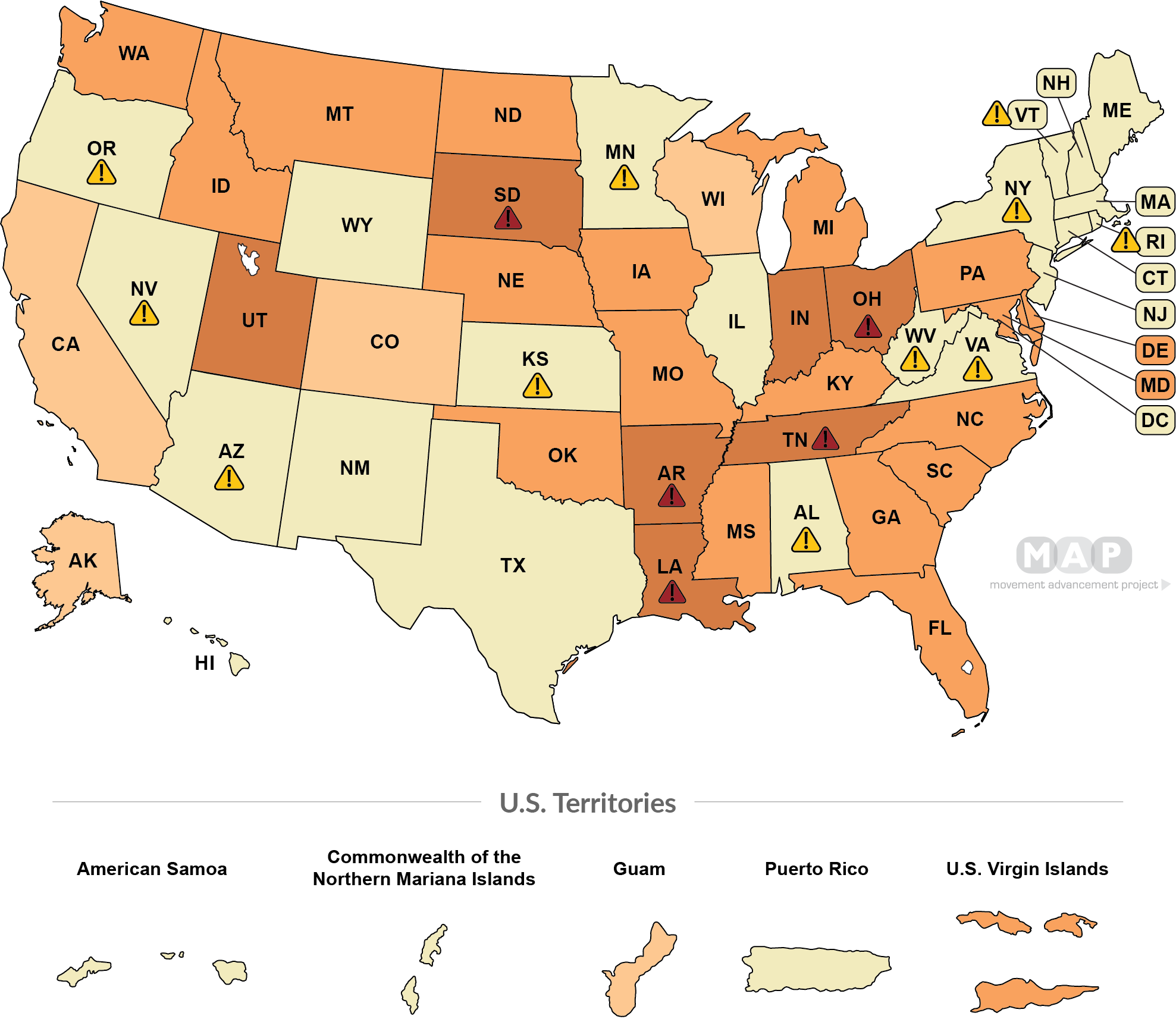MAP relies on the research conducted by the Center for HIV Law and Policy for this map and the statutes found below.

- State has HIV criminalization law and either HIV-specific sentencing enhancements or may require sex offender registration (or both) (7 states)
- State has HIV criminalization law (18 states, 1 territory)
- State has no HIV criminalization law, but does have HIV-specific sentencing enhancements for sex-related convictions (4 states, 1 territory)
- No HIV-specific law (21 states , 3 territories + D.C.)
- State has general STI/communicable disease law, which could be used to prosecute people living with HIV (11 states)
- State's HIV criminalization law may require sex offender registration (5 states)
For more information, contact The Center for HIV Law and Policy.
If you or someone you know is currently being charged with an HIV-related offense, please contact the Legal Help Desk at Lambda Legal by calling (866) 542-8336 or through this form.
Recommended citation:
Movement Advancement Project. "Equality Maps: HIV Criminalization Laws." https://www.lgbtmap.org/equality-maps/hiv_criminalization_laws. Accessed 11/25/2024.
Percent of Adult LGBTQ Population Covered by Laws
*Note: These percentages reflect estimates of the LGBTQ adult population living in the 50 states and the District of Columbia. Estimates of the LGBTQ adult population in the five inhabited U.S. territories are not available, and so cannot be reflected here.
- State does not have this law State has HIV criminalization law or policy
| State | HIV criminalization law and sentencing enhancements or sex offender registration (or both) | HIV criminalization law only | No HIV criminalization law but does have HIV-specific sentencing enhancements | No HIV-specific law |
| Citations | ||||
| Alabama | State has this law | |||
| Alaska | State does not have this law | |||
| American Samoa | State has this law | |||
| Arizona | State has this law | |||
| Arkansas | State does not have this law | |||
| California | State does not have this law | |||
| Colorado | State does not have this law | |||
| Connecticut | State has this law | |||
| Delaware | State does not have this law | |||
| District of Columbia | State has this law | |||
| Florida | State does not have this law | |||
| Georgia | State does not have this law | |||
| Guam | State does not have this law | |||
| Hawaii | State has this law | |||
| Idaho | State does not have this law | |||
| Illinois | State has this law | |||
| Indiana | State does not have this law | |||
| Iowa | State does not have this law | |||
| Kansas | State has this law | |||
| Kentucky | State does not have this law | |||
| Louisiana | State does not have this law | |||
| Maine | State has this law | |||
| Maryland | State does not have this law | |||
| Massachusetts | ||||
| Michigan | State does not have this law | |||
| Minnesota | State has this law | |||
| Mississippi | State does not have this law | |||
| Missouri | State does not have this law | |||
| Montana | State does not have this law | |||
| Nebraska | State does not have this law | |||
| Nevada | ||||
| New Hampshire | State has this law | |||
| New Jersey | ||||
| New Mexico | State has this law | |||
| New York | State has this law | |||
| North Carolina | State does not have this law | |||
| North Dakota | State does not have this law | |||
| Northern Mariana Islands | State has this law | |||
| Ohio | State does not have this law | |||
| Oklahoma | State does not have this law | |||
| Oregon | State has this law | |||
| Pennsylvania | State does not have this law | |||
| Puerto Rico | State has this law | |||
| Rhode Island | State has this law | |||
| South Carolina | State does not have this law | |||
| South Dakota | State does not have this law | |||
| Tennessee | State does not have this law | |||
| Texas | State has this law | |||
| U.S. Virgin Islands | State does not have this law | |||
| Utah | State does not have this law | |||
| Vermont | State has this law | |||
| Virginia | State has this law | |||
| Washington | State does not have this law | |||
| West Virginia | State has this law | |||
| Wisconsin | State does not have this law | |||
| Wyoming | State has this law | |||
| Totals | 7 states | 18 states, 1 territory | 4 states, 1 territory | 21 states , 3 territories + D.C. |


